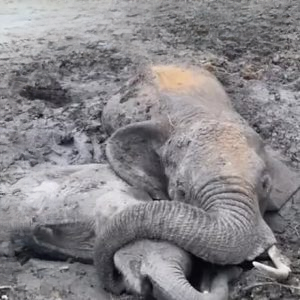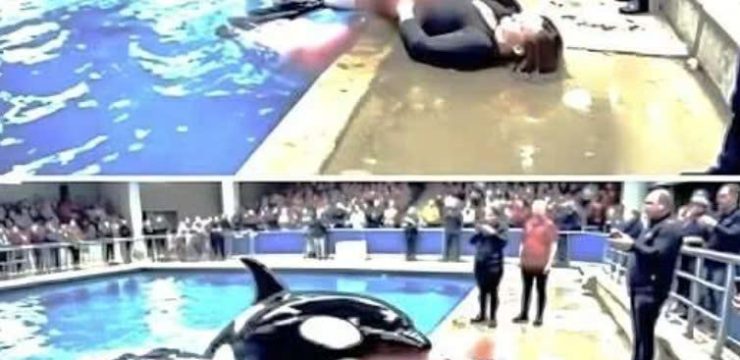Under the blazing Kenyan sun, the promise of water shimmered like a mirage across the arid plains. To a weary mother elephant and her young calf, that glimmer meant survival — a hope that, for two agonizing days, would turn into one of the most powerful stories of love, endurance, and compassion ever witnessed in the wild.

Kenya’s landscapes stretch endlessly — vast, breathtaking, and unforgiving. The land is both beautiful and brutal, a place where every drop of water is precious, and every journey comes with risk. In these wide plains, elephant herds rely on the wisdom of their matriarchs — mothers whose memory guides them to safety and sustenance. On one particularly harsh day, one such matriarch led her five-month-old calf through miles of parched earth in search of water. Dust clung to their skin, and the sun bore down without mercy. Then, in the distance, the pair spotted what looked like salvation — a shimmering pool reflecting the afternoon light.
But what appeared to be life was a trap. Beneath the thin crust of the muddy pool lay a deep pit of sludge — thick, sticky, and treacherous. Desperation drove the mother to step forward first. The moment her weight pressed into the surface, it gave way. Her massive legs sank deep, the suction trapping her with every movement. She trumpeted in alarm, her cries echoing across the barren landscape. Her calf, instinctively loyal and frightened, rushed in after her — and was swallowed by the same pit.
What followed was a struggle that stretched over two long, torturous days. The mother, fueled by sheer instinct and love, fought to lift her calf out of the mud. Again and again, she pushed and pulled, her trunk wrapping around her baby in protection. Her strength began to fade, yet she refused to stop. When the sun scorched the air, she shaded the calf with her body. When vultures circled above, she trumpeted warnings to keep them at bay. Every ounce of energy she had was spent keeping her child alive.
By the second day, her strength was nearly gone. The calf cried weakly, its small body trembling from exhaustion. Just when all seemed lost, faint sounds reached a nearby group of rangers. Those cries — raw and heart-wrenching — carried through the wind and reached the ears of people who would soon change everything. Responding immediately, members of the Kenya Wildlife Service, the Sheldrick Wildlife Trust, and Wildlife Works mobilized. They knew that in the heat of Kenya, time was the difference between life and death.
@sheldricktrust Leave no elephant behind. It’s an ethos that elephants live by — they are incredibly loyal and will only abandon their kind in the most dire circumstances. It’s also a mission that guides our conservation work. This stands out as one of our most heart-wrenching operations in recent years. During the drought, a mum and baby’s search for water turned into a death trap. Hopelessly stuck, the mother continued to protect her calf the only way she could, shielding him with her trunk. Her baby was equally brave, running back to his mum and refusing to leave her side. It was a monumental operation to rescue the pair — but we leave no elephant behind. Working in partnership with the Kenya Wildlife Service, we managed to free both mum and baby. It ended with the best possible outcome: two lives saved and a wild family kept together. We have been doing this work for the better part of a century. Decades in the field have taught us that no challenge is too great and that every life is worth saving. In fact, just last week we pulled off another monumental operation — we’ll share that story in the coming days. — In the lead-up to #WorldElephantDay (August 12), we are showcasing the different aspects of our work to secure a future for Kenya’s elephants — all made possible by donors like you. Join us in protecting Kenya’s elephants — become a donor or adopt an orphan today: sheldrickwildlifetrust.org 🐘 #sheldricktrust #elephants #animals #animalrescue #wildlife #mother #calf #mud #freed #savinglives #lifesaving #savinganimals #worldelephantday #sheldrickwildlifetrust ♬ original sound – SheldrickTrust
When the rescuers arrived, the sight broke every heart present. The mother, half-submerged, was still trying to protect her baby. Even as they approached, she attempted to fend them off, her maternal instincts unbroken. Understanding the danger, the veterinary team carefully tranquilized her — a delicate procedure to calm her without causing harm. Once she was sedated, the rescue team turned their attention to the calf.
The baby elephant, covered in thick mud, struggled to stand but refused to leave his mother’s side. Using ropes and incredible teamwork, the rescuers gently pulled the calf free. Cheers erupted when he was finally safe, though the moment was bittersweet. The calf kept returning to his mother, pressing his small head against her, unwilling to be separated even for a moment.
Freeing the mother was far more difficult. The mud gripped her like cement, and every pull was met with resistance. The team used tractors, ropes, and sheer determination. Their clothes were soaked, their arms trembling from the effort. Yet no one gave up. Inch by inch, they fought against the pit, and with one last coordinated pull, her massive frame finally broke free.
As the tranquilizer began to wear off, the mother stirred. Her trunk reached out weakly, then found her calf. The moment their bodies touched, a collective sigh swept through the rescuers. The calf nuzzled against her side, and the mother, now conscious, responded with a low, rumbling call — a sound that vibrated with relief, love, and gratitude. For those who witnessed it, it was more than a rescue; it was a lesson in devotion. Many said there wasn’t a dry eye among them.
In the days that followed, the rescue team monitored the elephants closely. The mother regained her strength slowly, supported by rest and hydration. Soon, her calls reached a nearby herd, and within days, they were reunited with their family. The reunion was nothing short of joyous — trumpets filled the air as trunks intertwined, expressing the unspoken bond that defines elephant kinship.
The muddy pit that had almost claimed two lives was later filled to prevent future tragedies. But its story lived on, spreading through schools, conservation centers, and across social media platforms around the world. People who had never set foot in Kenya felt connected to this act of love and survival. It became a symbol of hope — a reminder that even in moments of despair, compassion can prevail.
Experts later reflected on the deeper meaning of the rescue. It was a reminder of the emotional depth of elephants, whose intelligence and empathy mirror our own. Elephants grieve their dead, protect their young, and show affection in ways strikingly similar to humans. The story also highlighted the importance of conservation — the need for organizations like the Sheldrick Wildlife Trust, which dedicate their lives to saving these majestic creatures from drought, poaching, and human encroachment.
But perhaps the most powerful message came from the unity that made the rescue possible. Rangers, veterinarians, and local community members all worked together, driven by a shared mission to save life. Their teamwork reflected humanity at its best — compassionate, determined, and selfless.
In the heart of Kenya’s wilderness, this mother elephant’s story became more than a tale of survival. It became a reflection of the world’s interconnectedness — proof that love transcends species, and that resilience is a universal language. The image of the mother rising from the mud, embracing her calf under the golden light of the savannah, endures as a symbol of courage and hope.
If she could endure two days of struggle for her child, we, too, can endure for the sake of our planet. Her strength reminds us that compassion isn’t confined to humanity — it is a force shared by all living beings. Through her eyes, we see that the fight for life and love is what binds us together, across borders, across species, and across every hardship the earth may throw our way.





